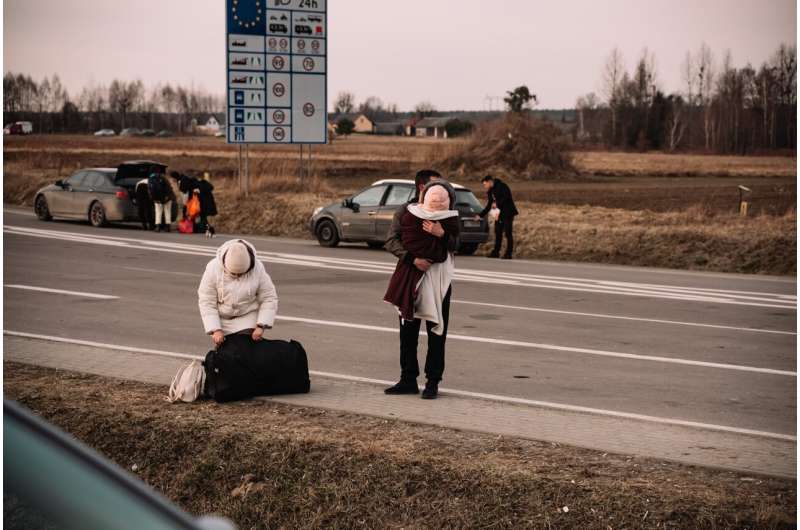This article has been reviewed according to Science X's editorial process and policies. Editors have highlighted the following attributes while ensuring the content's credibility:
fact-checked
trusted source
proofread
Latest European demographic data sheet highlights lasting impact of war and migration

The Russian invasion of Ukraine and the consequent displacement of millions of people will have a significant impact on the country's long-term population structure. Researchers from the Austrian Academy of Sciences, IIASA, and the University of Vienna are forecasting a substantial population decline of 21–31% by 2052.
The latest edition of the European Demographic Data Sheet, which is published every two years by scientists from the Institute of Demography of the Austrian Academy of Sciences and the Wittgenstein Centre for Demography and Global Human Capital—a collaborative center of the Austrian Academy of Sciences (Vienna Institute of Demography), IIASA, and University of Vienna—reveals the long-term impact of the Russian war of aggression in Ukraine on population size and structure. Additionally, it examines and visualizes population trends in 45 European countries.
Largest migration flow in recent European history
The Russian invasion of Ukraine in February 2022 resulted in the largest population displacement in Europe since the period after World War II. By mid-2023, 5.9 million people, primarily women, had fled Ukraine, while an additional 5.1 million were displaced within the country.
"The war in Ukraine has triggered the largest migration flow in Europe since the expulsion of Germans from many countries after the Second World War," says Tomáš Sobotka from the Institute of Demography at the Austrian Academy of Sciences in Vienna, one of the editors of the European Demographic Datasheet.
"This movement has dramatically accelerated the long-term trend of population decline and low birth rates in Ukraine, and it will have a lasting negative impact on the country's population structure and dynamics for many decades to come. The latest analyses also highlight the significant role migration will play in Ukraine's future demographic changes."
The impact of migration on Ukraine's population
IIASA Population and Just Societies Program Director, Anne Goujon, a demographer and one of the primary authors of the study, collaborated with the European Commission Joint Research Centre to analyze the impact of four distinct migration scenarios on population projections until 2052.
"Exploring potential futures using 'what-if' scenarios with varying assumptions is necessary to provide policymakers with a nuanced picture of how migration could impact the future of the Ukrainian population. More importantly, this research can help to make informed decisions about the allocation of support in line with the country's needs," she explains.
In the most pessimistic scenario of "long war and low return," the population could shrink by 31%. Even in an optimistic scenario where Ukraine quickly recovers, a population decline of 21% is forecasted. These scenarios underscore that migration will be as pivotal as fertility and mortality for population dynamics in the Ukraine post-war period.
According to the researchers, the expected sharp population decline is accompanied by the challenges of an aging population and a shrinking work force, which will put further strain on the country's economy and social security systems.
Where are the Ukrainian refugees?
"In addition to Germany, many refugees have fled to nearby European countries, especially Poland and the Czech Republic, which historically had a low proportion of refugees in their population," notes Sobotka.
By mid-2023, 976 thousand Ukrainians had found refuge in neighboring Poland, and one million in Germany. In mid-2023, 349 thousand Ukrainian refugees were living in the Czech Republic, 213 thousand in the UK, 178 thousand in Spain, 165 thousand in Italy, and 161 thousand in Bulgaria. 100 thousand people from Ukraine have fled to Austria.
The countries with the relatively highest proportions of Ukrainian refugees in relation to their total population are Montenegro (6.8%), Moldova (4.3%), and the Czech Republic (3.2%), as well as the Baltic states of Estonia (2.8%), Lithuania (2.4%), and Latvia (2.3%). In Austria, the share is 1.1%.
More information: European Demographic Data Sheet: www.populationeurope.org/en/




















